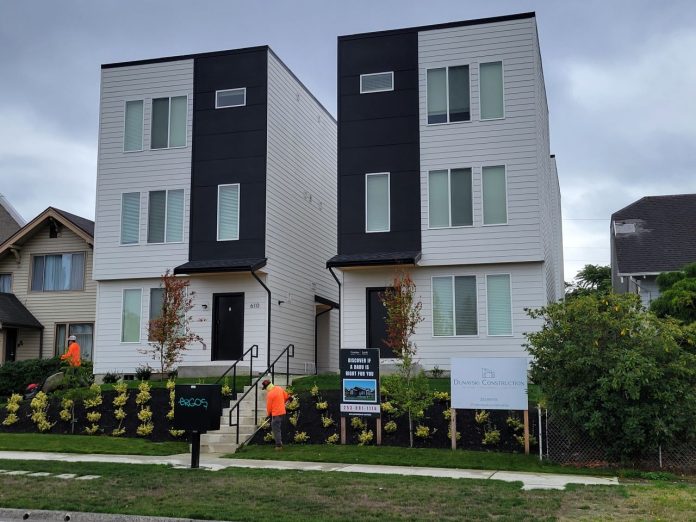
Home in Tacoma is reaching its penultimate stages with the release of the initiative’s Final Environmental Impact Statement (EIS) in August 2024. This is a quick guide on the key components and findings of the 397-page EIS document outlining the impacts of the Home in Tacoma zoning and land use changes.
Environmental impact Statements are discussions of alternatives under consideration, their respective environmental impacts, and mitigation measures to minimize those potential effects. These documents help policymakers understand the most salient risks and benefits associated with a given project. Both state and federal environmental laws have thresholds determining when local authorities must produce an EIS before embarking on the planned project or land use action, such as the zoning overhaul called for by Home in Tacoma. The EIS was prepared by the Civil Engineering firm Parametrix with the support of City of Tacoma planners.
Home in Tacoma’s Final EIS will inform any final changes or adjustments to the proposal that city council makes before being formally adopted and integrated into city policies. The City is accepting written public comments on the EIS at cityclerk@cityoftacoma.org until Monday, September 23 at 5pm. The Tacoma City Council is hosting a public hearing on Tuesday, September 24 starting at 5:15pm in Council Chambers, with both in-person and virtual comment options.
The Home in Tacoma Final EIS discusses 10 categories of impacts across three potential rezoning scenarios. EIS studies traditionally interpret “environment” broadly when studying impacts, including impacts to cultural resources, parking, and even aesthetics, in addition to more obvious ecological concerns. The three scenarios are: No Action/Baseline, Lower Zoning, and Higher Zoning, which are differentiated by the increasing degree of housing density allowed.

The EIS includes estimated net housing production figures under each scenario through 2050. The Lower Zoning Alternative would add net new capacity for 334,705 homes, and the Higher Zoning Alternative more than twice that at 700,734 net new homes. Planners project that that capacity would result in 25,660 likely net new homes by 2050 in the Lower Alternative, and 53,620 net homes in the Higher Alternative. Since, Tacoma has 66,235 existing housing units, the Higher Zoning scenario would represent 80% growth in housing over the next three decades, if those projections are on the mark.
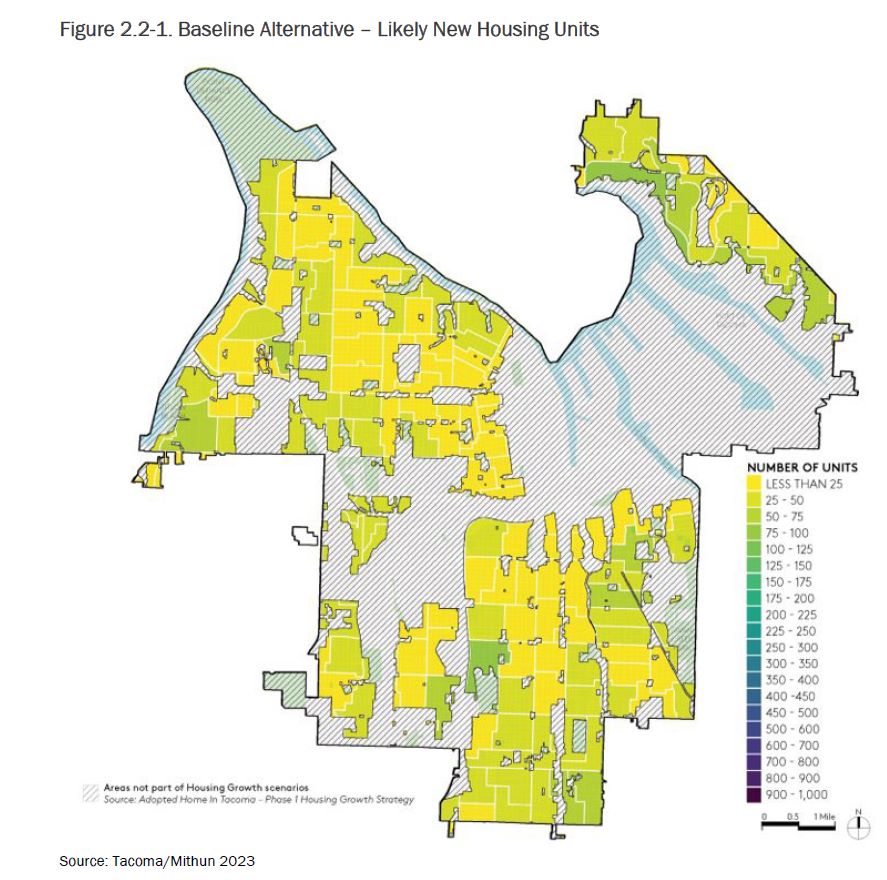
The first “no action” scenario models organic growth of the housing stock with no Home in Tacoma implementation with an estimated 3,800 units added. This no action scenario is no longer possible due to state legislation mandating increased density in most Washington cities, but is still included as a baseline for comparison, as required in state law.
The Lower Zoning Alternative
The Lower Zoning Alternative models a medium increase in housing density with about 25,000 units projected to be added by 2050, representing a moderate application of Home in Tacoma. This Lower Zoning Alternative would allow 4 units per 6,000 sq ft lot in Low-Scale residential zones and 6 units in Mid-Scale areas. In addition to single family homes, rebranded houseplexes in the study, this option identifies detached accessory dwelling units (DADUs), rowhouses, courtyard apartments and multiplexes as acceptable housing types. All of the housing types top out at 35 feet of allowed height or three stories.
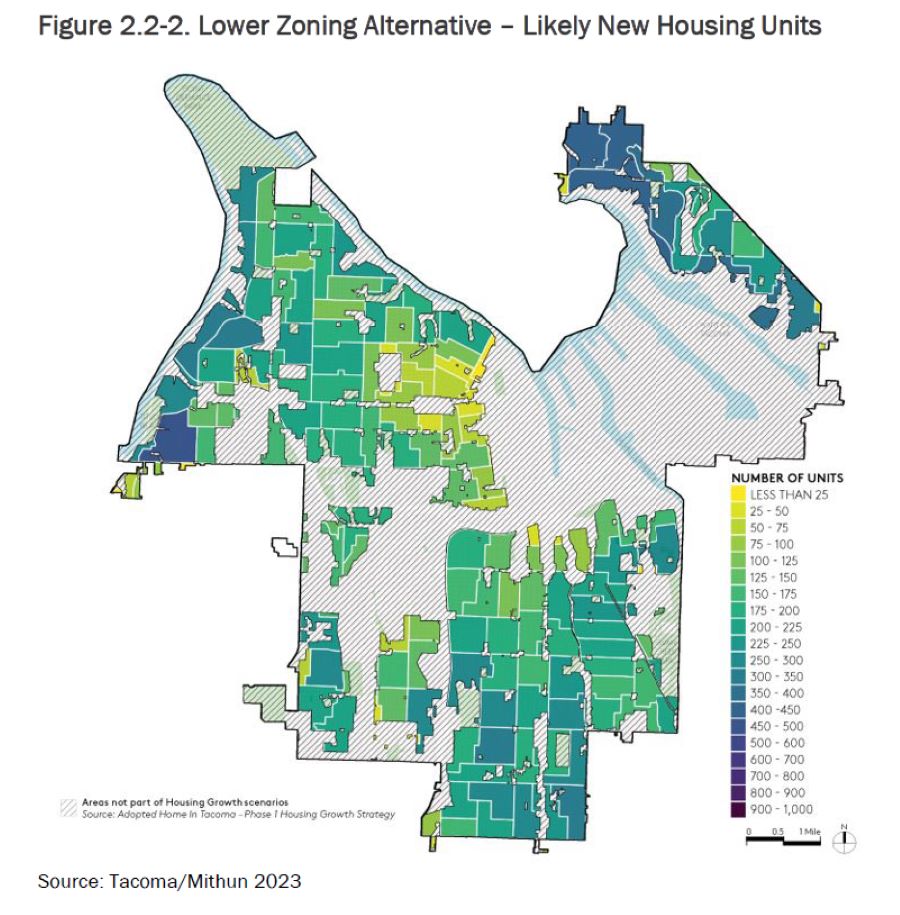
The maps of the scenarios above note that some areas could receive less than 25 new units to as many as 500 across these different housing varieties, with new apartment buildings rising up in some neighborhoods, while others could see backyard ADUs contribute to the local housing stock.
The EIS authors project much of the new mid-scale development would occur in the outer regions of the city, with decreasing middle housing construction towards the downtown core. Additionally, more growth is estimated to occur in the southern portion of the city compared to the northern, though there are small concentrations of high growth to the city’s northwest and in the Brown’s Point neighborhood. There are also clear increases in density near designated urban centers such as the Proctor and Lincoln Business districts and along SR-7.
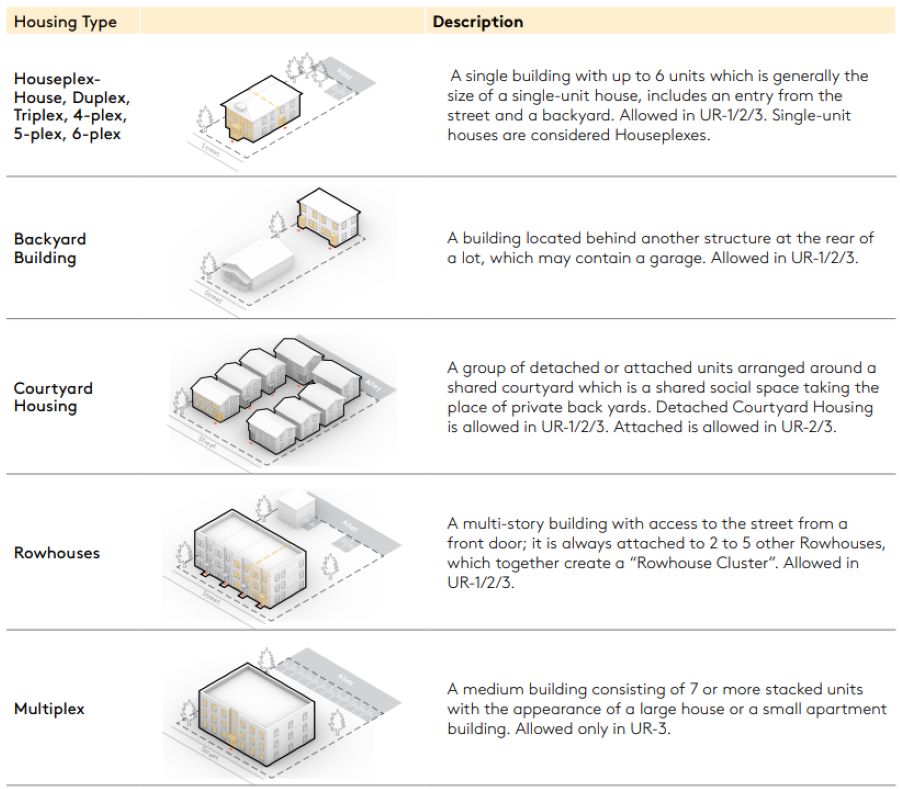
These findings align with the Tacoma Equity Index’s classification of higher need areas throughout the city in addition to previously stated strategies of increasing density near existing amenities and infrastructure. The eastern portion of the 6th Avenue Business District seems to be spared the greatest degree of growth, but this is likely due to already existing medium to high density, smaller lot sizes, historical designations and their proximity to the higher density downtown residential areas, such as Hilltop. This area is also where your author previously found a “Don’t Seattle My Tacoma” Yard sign.
The Higher Zoning Alternative
The Higher Zoning Alternative models a more intense application of Home in Tacoma with about 53,000 units added. The Higher Alternative would allow for eight units per 6,000 sq ft lot in Low-Scale areas and 12 units per lot in Mid-Scale zones, allowing for all the housing types above at even higher densities with up to four stories allowed. This scenario follows the same spatial trends as noted in the Lower Zoning Alternative, but at a much greater rate of development, with some areas adding around 50 units to as many as 1000 in the coming decades.
At least half of the areas noted in the Higher Zoning map are estimated to be adding over 300 units, showing a high potential for increased housing stock throughout the city rather than just in specific high need areas. These align with Home in Tacoma’s goals of anti-displacement and housing affordability regardless of location.
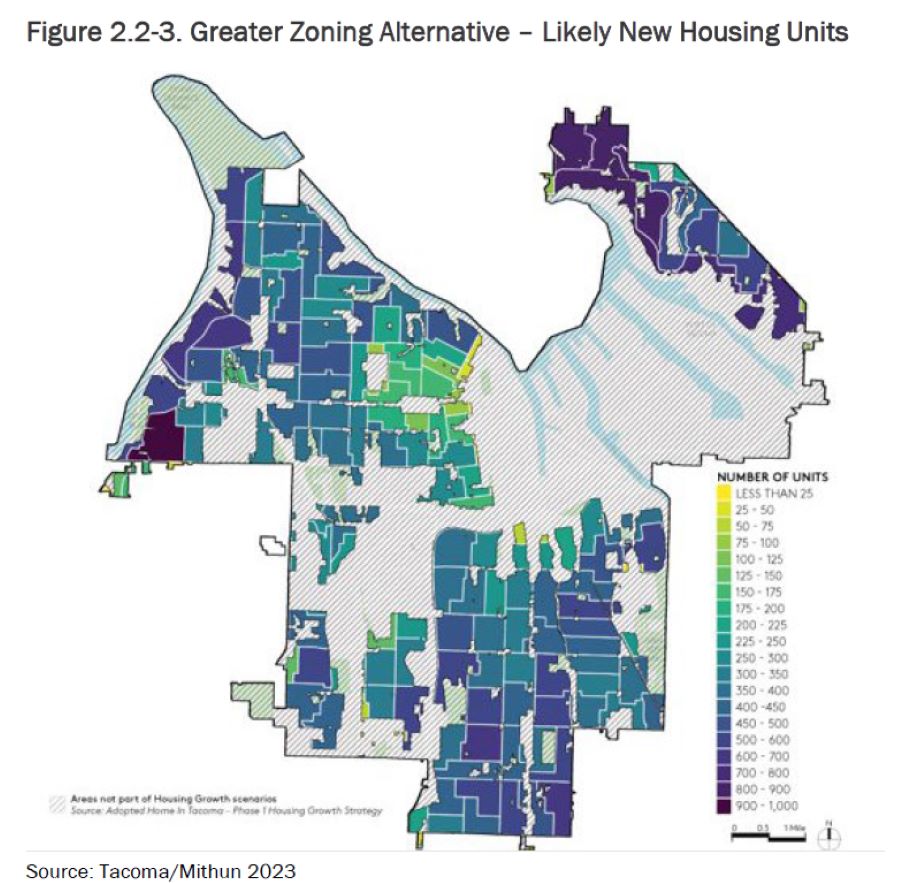
These scenarios are not official policy packages, rather they are potential outcomes based on probable degrees of change and adoption of Home in Tacoma. One could argue that Tacoma needs to add even more housing if it intends to end the housing affordability crisis. Regardless, what’s clear in any scenario is Tacoma needs tens of thousands of more housing units as quickly as possible. Anything less will leave Tacoma in the same situation of rapidly rising housing costs and displacement pressure.
The long-term housing production estimates used in EIS studies are crude instruments that are not certain to come to pass, since many variables come into play to determine the rate of housing growth. The estimated number of new housing units is based on population growth projections modeled through 2050.
Tacoma’s planners note that the city has fallen short of previous growth estimations and thus the calculated number of added housing units is likely a high-end estimate. They add that there is no expectation of rapid redevelopment, rather redevelopment would occur incrementally over the upcoming 30 years throughout the city. The authors estimate that up to 7.5% of currently occupied lots and 12% of vacant lots may be redeveloped in the coming years. It will ultimately fall upon property owners and developers to decide to redevelop their properties and set the pace for housing growth in Tacoma. Home in Tacoma is a change in rules, not a requirement that property owners redevelop.
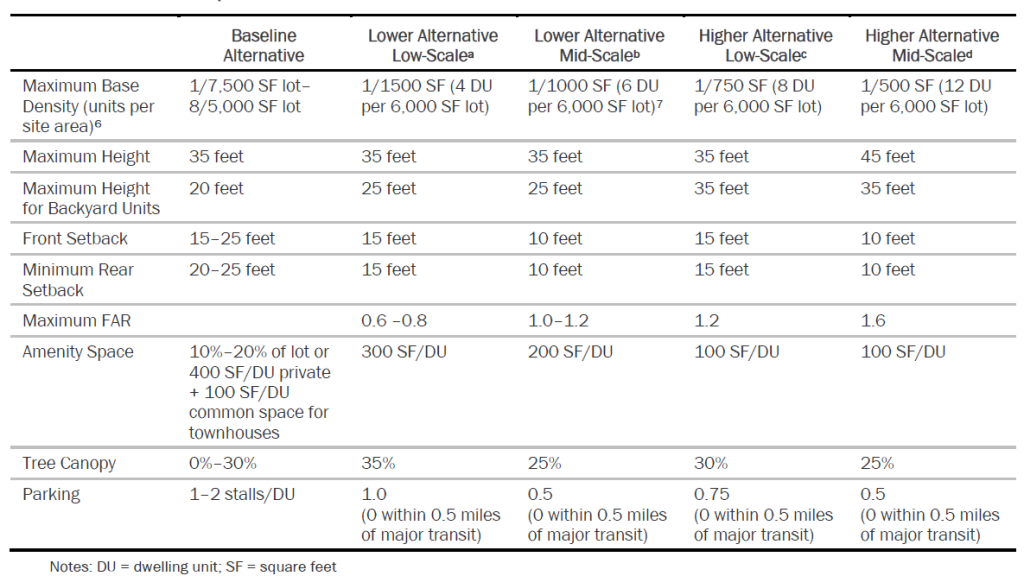
Actual numbers of units constructed will also depend upon the degree to which homebuilding is encouraged and Home in Tacoma is embraced and implemented into City policy.
Diving into Home in Tacoma environmental impacts
With the sweeping changes proposed in Home In Tacoma, impacts on the environment, both natural and built, are unavoidable. However, broadly speaking, the EIS finds that there would not be significant adverse impacts to the local environment and that most negative impacts could be mitigated by appropriate city responses.
Further, the growth strategy employed by Home in Tacoma resembles a hub and spoke model where urban growth is highly supported around regional centers that are connected by higher capacity roads and public transit. This allows a city to accommodate growth while concentrating much of the redevelopment to more developed and accessible areas.
“Focusing growth in an already urbanized area, per adopted regional growth policies and consistent with ‘smart growth strategies,’ can result in direct and indirect environmental benefits to the natural environment, including minimizing air and water pollution, reducing GHG emissions, conserving resources, and preserving natural and environmentally sensitive lands,” the EIS notes. “As a result, the Proposal is likely to have beneficial impacts to the natural environment, in addition to any localized potential adverse impacts identified throughout this Draft Final EIS. Although the Proposal is anticipated to have beneficial impacts to some elements of the environment within Tacoma and when considered at a more regional scale, the focus of this EIS is to identify any potential significant adverse impacts.”
The 10 categories of environmental impacts analyzed in the EIS include:
- Plants and Animals
- Water Resources
- Air Quality and Greenhouse Gas Emissions
- Land Use
- Housing
- Transportation
- Public Services
- Utilities
- Parks and Recreations
- Historic, Cultural and Archaeological Resources
See the EIS for a full discussion, but for now I’ll review the climate, housing, and transportation impacts and proposed mitigations that will be of particular interest.
Air Quality and Greenhouse Gas Emissions
Tacoma’s diverse zoning, ranging from residential to heavy industrial, presents unique challenges for air quality. The City’s analysis of 2015 data found that vehicles accounted for 28% of Tacoma’s air pollution. 20% came from personal vehicles while the remaining 8% came from commercial vehicles. The Home in Tacoma plan is likely to increase local emissions due to construction equipment, higher traffic volumes, and ongoing use of new developments.
Energy consumption is projected to grow under all scenarios. Tacoma Power is the sole electricity provider to the City, with a majority coming from renewable sources such as hydroelectric and wind. While Tacoma Power currently has no issue providing power to all of its customers, future growth may strain the system and require non-renewable energy generation to keep up with demand. The authors admit a large degree of uncertainty in estimating future energy consumption, as ongoing state and federal decarbonization efforts muddle the local impacts of climate change.
For example, adoption of electric vehicles and fleets could decrease petroleum demand and emissions for both personal and commercial vehicles while increasing electricity demand across the board. But a huge increase in electricity may require petroleum or other non-renewable energy sources to come online to fill the need, leading to increased emissions from direct power generation. The authors state that Tacoma Power is analyzing many potential scenarios to strategize their energy portfolio against future growth, with many scenarios demanding additional power sources.
Housing
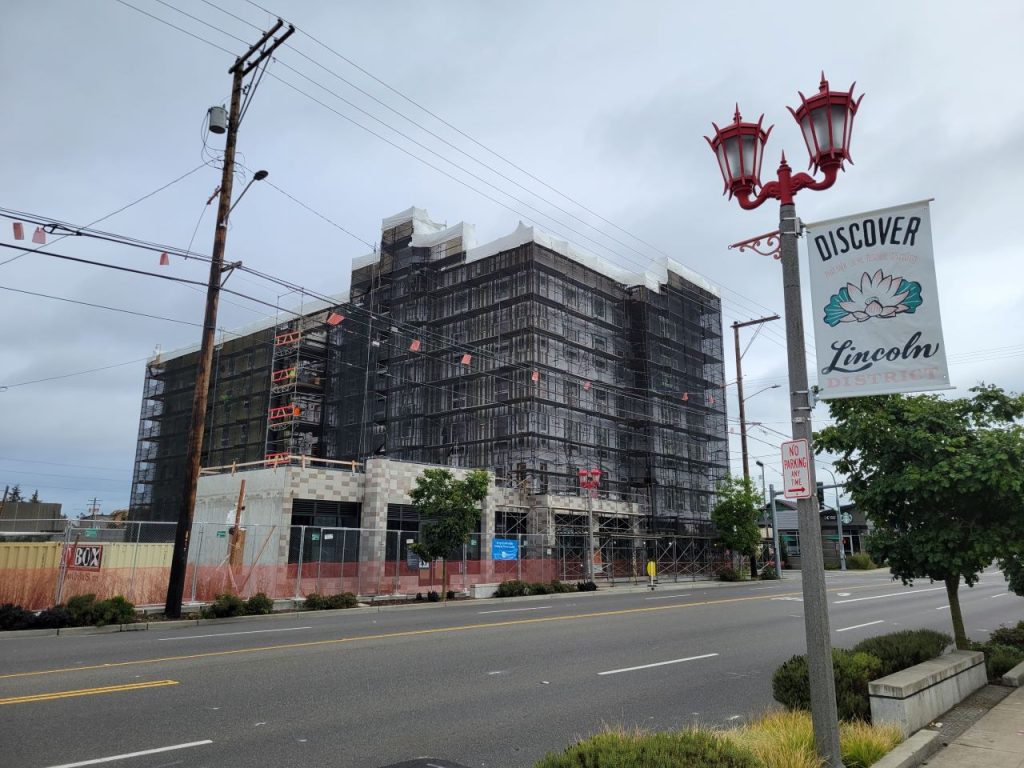
Tacoma’s housing market is characterized by a majority of single-family dwellings, with an ongoing need for more diverse and affordable housing options. Recent housing developments have increased rents and housing values, particularly in areas like Ruston and Downtown. The City of Tacoma has passed various measures to prevent displacement, including a resolution working to develop affordable housing in high need areas of the city and expanded tenant protections. While the Home in Tacoma plan aims to increase housing supply and affordability and states that anti-displacement of current residents as a priority, the authors admit that there is a risk of displacement as new developments may drive up local rents in the short term. However, the long-term increase in housing stock could help mitigate displacement risks, and the introduction of middle housing is expected to exert downward pressure on local housing values.
Even with local and regional efforts to increase affordable housing, homebuilders face significant headwinds and obstacles. For example, an apartment development adjacent to the Tacoma Dome called Tacoma Trax that was intended to house over 100 affordable housing units as one part of an anti-displacement strategy.
Unfortunately, the original developer was unable to fulfill their financial duties, and ownership of the property fell to the lender, real estate group Cushman & Wakefield. Work slowed to a crawl in November 2023 and stopped entirely in March 2024. Since then, Cushman & Wakefield has been seeking a new buyer for the property, with no completion date on the horizon. The uncompleted project sits next to the Tacoma Dome’s Sounder station and streetcar stop.
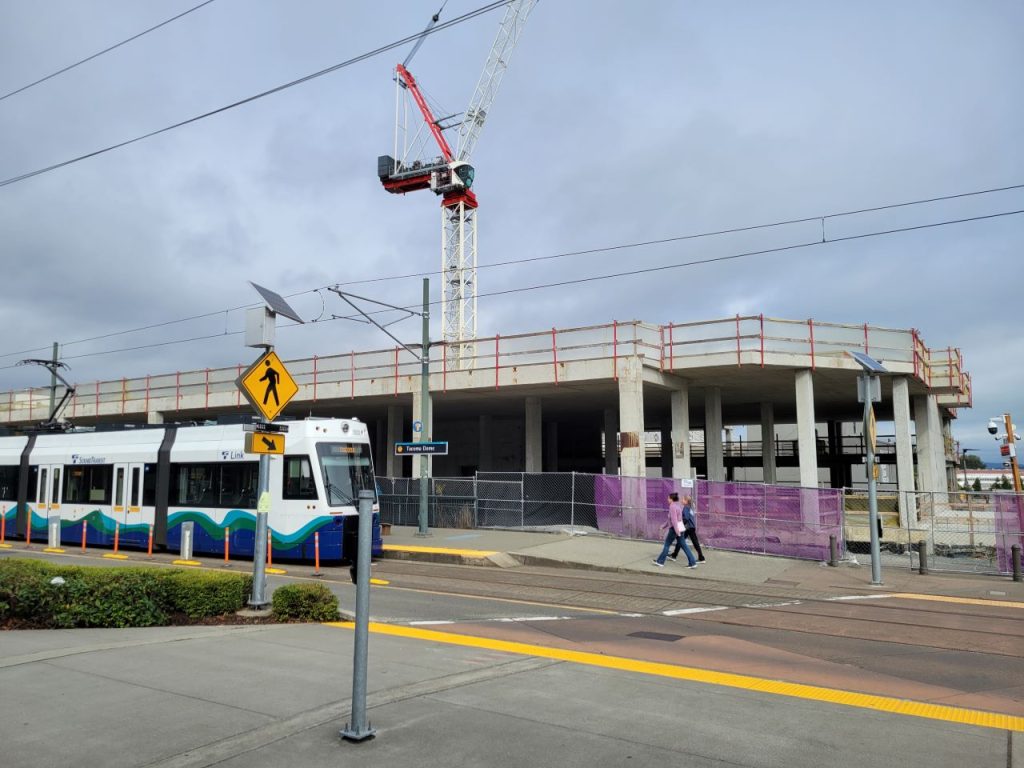
Transportation
Population growth will lead to increased use of walking, biking, and public transit, although these modes have not yet fully recovered to pre-pandemic levels. Personal vehicle use is expected to rise, resulting in increased traffic and potential impacts on public transit and pedestrian safety. Planned improvements, such as enhancements to Pierce Transit’s Route 1 along SR-7, aim to address these issues. While personal vehicle travel is expected to rise with increased density, overall rates of vehicle ownership and vehicle miles traveled per capita is expected to decrease with greater density and greater public transit use, which local officials would be wise to encourage with service upgrades. Increased traffic will likely be felt throughout the city, but primarily in and around designated growth areas expected to accommodate much of the growth.
With population growth in all scenarios, the City projects demand for emergency services will rise, necessitating increased investments in personnel and facilities for both the Tacoma Fire Department and Tacoma Police Department. The EIS states that currently both the fire and police departments are understaffed, leading to struggles in maintaining low response times to calls. Increased traffic would further challenge emergency response times, the City notes.
What will ‘Home’ look like in Tacoma?
To learn more about changes across all categories and comparisons of impacts between scenarios, check out the EIS starting on page 19. There is also a two page summary sheet for the EIS outlining key findings.
Overall, Tacoma’s approach to addressing housing needs through zoning changes involves a complex balance of environmental stewardship, infrastructure development, and historical protection. As the city navigates these multifaceted challenges, strategic planning will be critical to ensuring sustainable growth and protecting valuable resources.
To read the Final Environmental Impact Statement yourself, visit the Home in Tacoma project webpage. The City is accepting written public comments at cityclerk@cityoftacoma.org until September 23rd at 5pm. City Council is hosting a public hearing on September 24th in Council Chambers to review written comments and hear from community members directly. Details here:
- In-Person – City Council Public Hearing: Tuesday, September 24, 2024 – doors open 5:15pm, 747 Market Street, Council Chambers, Tacoma, WA 98402
- Virtual – via Zoom: Tuesday, September 24, 2024 – room opens 5:15pm, Meeting Login: www.zoom.us/j/84834233126 (Passcode: 349099) Dial-in Option: 253-215-8782 (Meeting ID: 848 3423 3126)

Kevin Le
Kevin Le is a Geographic Information Science (GIS) professional in Tacoma. He enjoys studying spatial data to better understand our urban landscapes and redesign cities to better serve all people.

